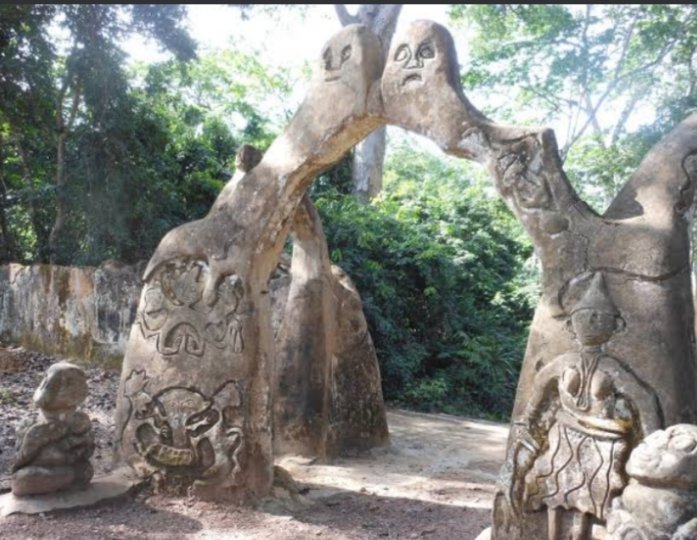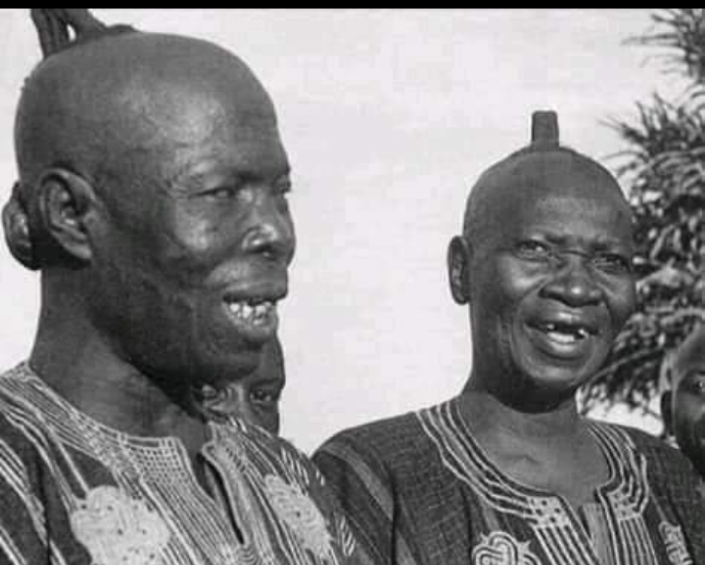
The funeral of Aláàfin in the old Oyo kingdom.
It's very important to know about our past and present culture and tradition.
Even though some of this custom are now abolished.
In the old Oyo kingdom,the Aláàfin are buried in the Barà.

It's very important to know about our past and present culture and tradition.
Even though some of this custom are now abolished.
In the old Oyo kingdom,the Aláàfin are buried in the Barà.


The funeral usually takes place at night.
It is notified to the public by the sounding of the Okinkin, the ivory trumpet, and the Koso drum.
A drum which is usually beaten every morning at 4.am,as a signal for the Aláàfin to rise from
It is notified to the public by the sounding of the Okinkin, the ivory trumpet, and the Koso drum.
A drum which is usually beaten every morning at 4.am,as a signal for the Aláàfin to rise from
The bed,to beat the Koso drum at night.
Therefore is to indicate that he is retiring to his final resting place.
The body is moved to the Barà on the back of those whose duty is to bury the Aláàfin.
The chief of whom is a titled personage
Therefore is to indicate that he is retiring to his final resting place.
The body is moved to the Barà on the back of those whose duty is to bury the Aláàfin.
The chief of whom is a titled personage
Known as the Ona-Onse-awo and his lieutenants.
At certain place on the route between the palace and Barà.
Eleven in all,they halt and immolate a man and a ram.
Also at the Barà,four women each at the head and at the feet.
At certain place on the route between the palace and Barà.
Eleven in all,they halt and immolate a man and a ram.
Also at the Barà,four women each at the head and at the feet.
Two boys on the right and on the left,were usually buried with the dead monarch.
On the same grave with the dead monarch.
All these practices and customs have been abolished.
A horse and a bullock is being used now instead of Human beings.
On the same grave with the dead monarch.
All these practices and customs have been abolished.
A horse and a bullock is being used now instead of Human beings.
The dead monarch (Aláàfin) is buries in black and white.
The Barà in which the dead monarch (Aláàfin) are buried are not open to the public.
Iyamode, the most senior priestesses and the superior celibate of the celibacy living in Barà generally styled
The Barà in which the dead monarch (Aláàfin) are buried are not open to the public.
Iyamode, the most senior priestesses and the superior celibate of the celibacy living in Barà generally styled
"Baba" (father) is devoted to the worshiping of Sàngó.
She is also a person who embodies in the flesh a diety or spirit.
Thus regarded as the incarnation of a king.
Addition are made to their number at every fresh burial.
She worshipped the spirit of the
She is also a person who embodies in the flesh a diety or spirit.
Thus regarded as the incarnation of a king.
Addition are made to their number at every fresh burial.
She worshipped the spirit of the
The departed Aláàfin.
Awirere aboju sinsin
Ni oruko ti a pe awon iyami
Amuje enia ma bi
Iba yin ni mose ooo
The members of the royal family and other people to die after the dead monarch (Aláàfin) were
Awirere aboju sinsin
Ni oruko ti a pe awon iyami
Amuje enia ma bi
Iba yin ni mose ooo
The members of the royal family and other people to die after the dead monarch (Aláàfin) were
Aremo(crown prince);
Who reigned with his father (Aláàfin) who enjoyed great royal privileges.
Three princes with hereditary titles;
The Magaji Iya yin,the Agunpopo and the Olusanmi.
The two titled personages;
The Osi-wefa and the Olokun-esin
Who reigned with his father (Aláàfin) who enjoyed great royal privileges.
Three princes with hereditary titles;
The Magaji Iya yin,the Agunpopo and the Olusanmi.
The two titled personages;
The Osi-wefa and the Olokun-esin
(master of the horse) who is also styled "Ab'obaku" meaning one who is to die with the king.
Iya Oba;
The Aláàfin's official mother as she is 'demand to go and rest in peace'.
Iya Naso;(she is in charge of a spiritual room)
Iya-lalagbo(the crown
Iya Oba;
The Aláàfin's official mother as she is 'demand to go and rest in peace'.
Iya Naso;(she is in charge of a spiritual room)
Iya-lalagbo(the crown
Prince's mother)
Iya-le-mole(Ifa priestess)
Olorun-kumefu or Orun-Kumefun (she's also in charge of the welfare of the crown prince)
Aare Orite(the Aláàfin's personal assistant)
Are all demand to go and rest in peace.
Iya-le-mole(Ifa priestess)
Olorun-kumefu or Orun-Kumefun (she's also in charge of the welfare of the crown prince)
Aare Orite(the Aláàfin's personal assistant)
Are all demand to go and rest in peace.
The custom is that each should go and die in their own home.
They will be buried decently by thier family and relatives and their funeral rites performed.
Some of the Aláàfin Ilaris(slave) who are not require to die also commit sucide
They will be buried decently by thier family and relatives and their funeral rites performed.
Some of the Aláàfin Ilaris(slave) who are not require to die also commit sucide
Voluntarily inorder to go and serve their master (Aláàfin) in the other world.
Sources; thehistoryofYoruba, cambridge.
The present Aláàfin of Oyo.
Oba Lamidi Adeyemi 111
Alase igba keji Orisa
Iku baba yeye
Ire o loruko meji
Sources; thehistoryofYoruba, cambridge.
The present Aláàfin of Oyo.
Oba Lamidi Adeyemi 111
Alase igba keji Orisa
Iku baba yeye
Ire o loruko meji
A fi ire
Akalamagbo ki s'alai lo egberun odun laye
Emi yin à gun laye
Kabiyesi oooo
Meaning;
One with authority,the second in command of the gods
The one that eschew death for life
Goodness doesn't have two name
Goodness will forever be yours
Akalamagbo ki s'alai lo egberun odun laye
Emi yin à gun laye
Kabiyesi oooo
Meaning;
One with authority,the second in command of the gods
The one that eschew death for life
Goodness doesn't have two name
Goodness will forever be yours
Bucorvidea doesn't die until it has spent 1000 years on earth
You will live long
Kabiyesi oooo
Stay tuned for more amazing stories
Èmi ni Bólánlé oní story 🖋️
You will live long
Kabiyesi oooo
Stay tuned for more amazing stories
Èmi ni Bólánlé oní story 🖋️
• • •
Missing some Tweet in this thread? You can try to
force a refresh













